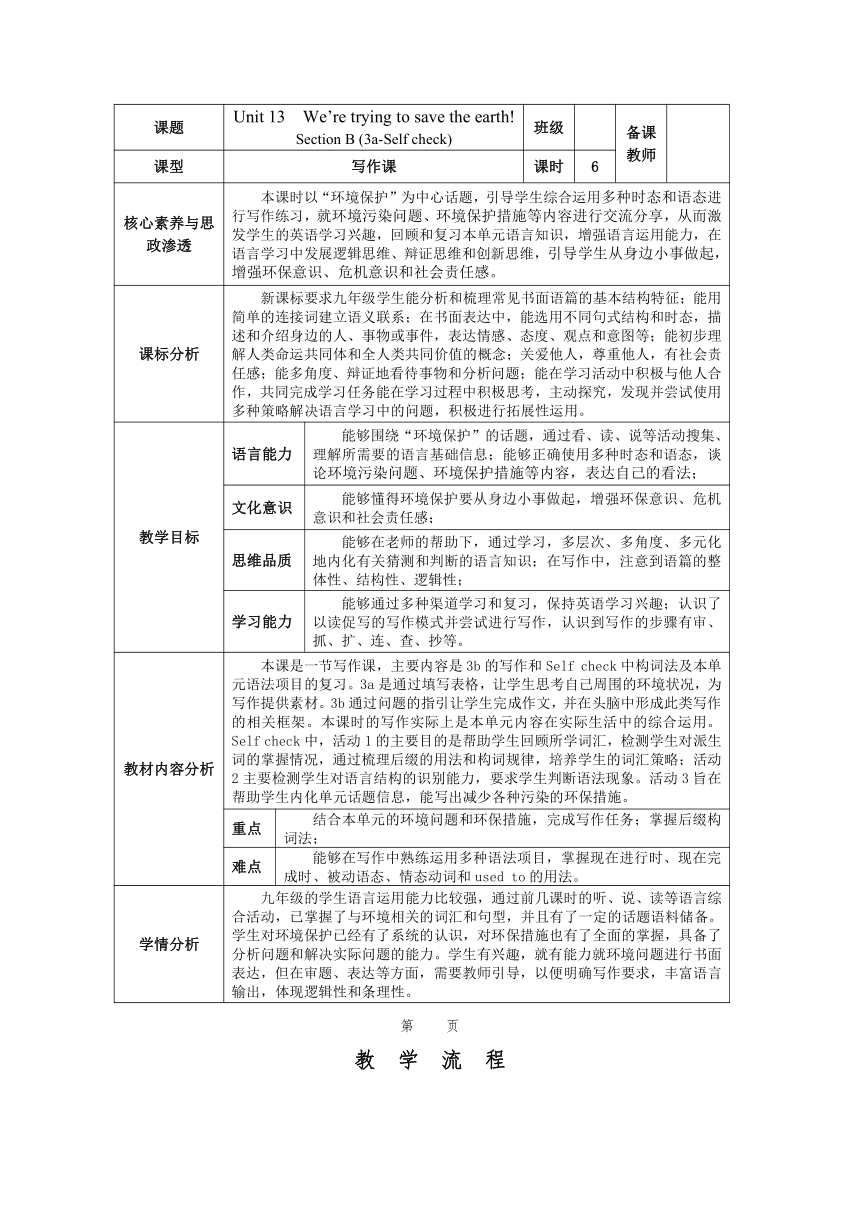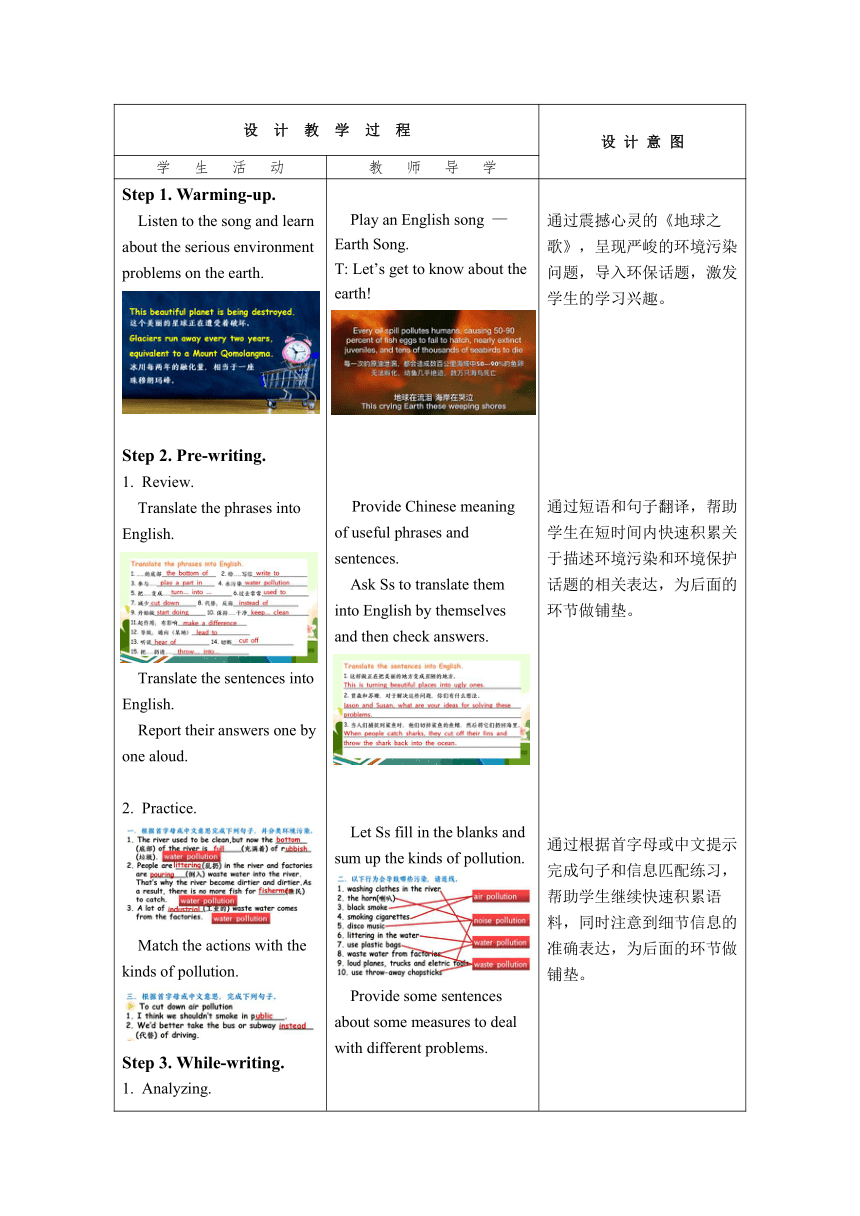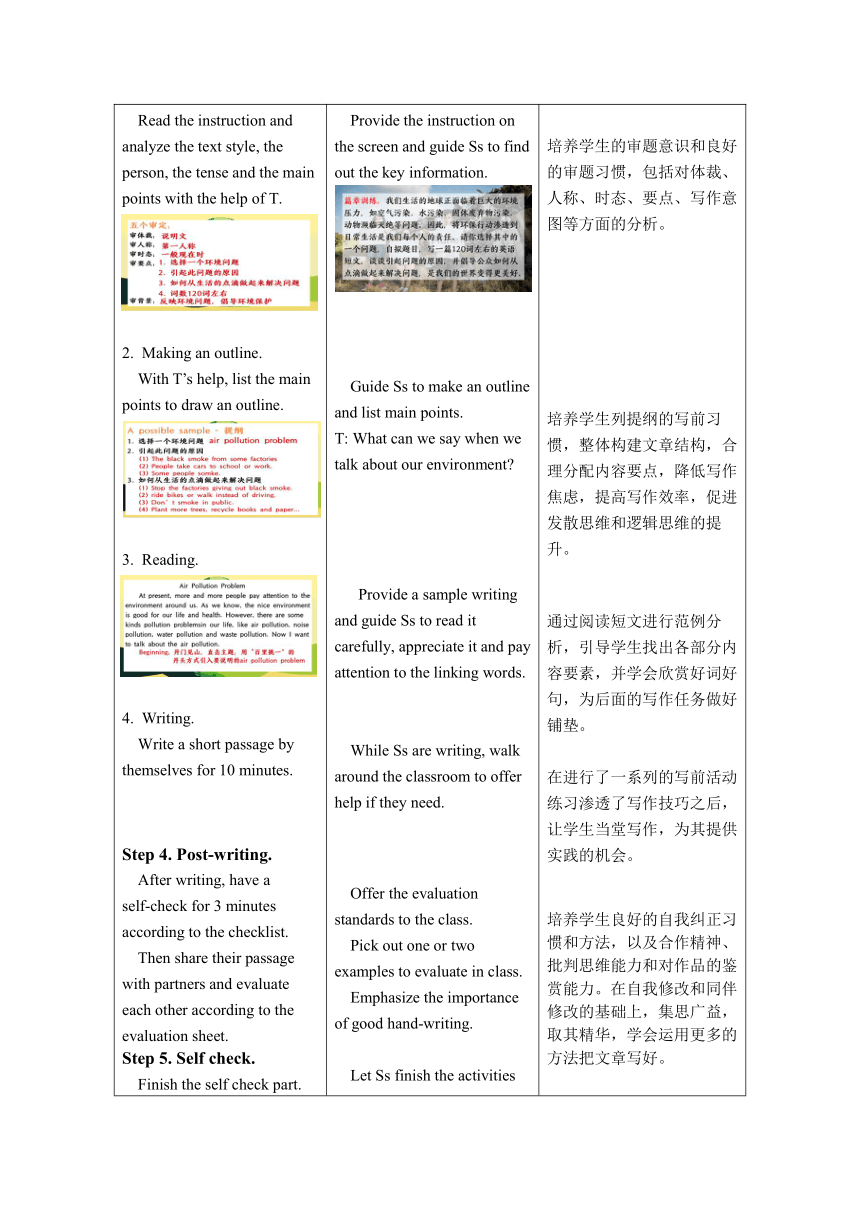【核心素养目标】Unit 13 We’re trying to save the earth! Section B (3a-Self check)表格式教案
文档属性
| 名称 | 【核心素养目标】Unit 13 We’re trying to save the earth! Section B (3a-Self check)表格式教案 |  | |
| 格式 | docx | ||
| 文件大小 | 2.6MB | ||
| 资源类型 | 教案 | ||
| 版本资源 | 人教新目标(Go for it)版 | ||
| 科目 | 英语 | ||
| 更新时间 | 2024-09-25 16:16:48 | ||
图片预览



文档简介
课题 Unit 13 We’re trying to save the earth! Section B (3a-Self check) 班级 备课教师
课型 写作课 课时 6
核心素养与思政渗透 本课时以“环境保护”为中心话题,引导学生综合运用多种时态和语态进行写作练习,就环境污染问题、环境保护措施等内容进行交流分享,从而激发学生的英语学习兴趣,回顾和复习本单元语言知识,增强语言运用能力,在语言学习中发展逻辑思维、辩证思维和创新思维,引导学生从身边小事做起,增强环保意识、危机意识和社会责任感。
课标分析 新课标要求九年级学生能分析和梳理常见书面语篇的基本结构特征;能用简单的连接词建立语义联系;在书面表达中,能选用不同句式结构和时态,描述和介绍身边的人、事物或事件,表达情感、态度、观点和意图等;能初步理解人类命运共同体和全人类共同价值的概念;关爱他人,尊重他人,有社会责任感;能多角度、辩证地看待事物和分析问题;能在学习活动中积极与他人合作,共同完成学习任务能在学习过程中积极思考,主动探究,发现并尝试使用多种策略解决语言学习中的问题,积极进行拓展性运用。
教学目标 语言能力 能够围绕“环境保护”的话题,通过看、读、说等活动搜集、理解所需要的语言基础信息;能够正确使用多种时态和语态,谈论环境污染问题、环境保护措施等内容,表达自己的看法;
文化意识 能够懂得环境保护要从身边小事做起,增强环保意识、危机意识和社会责任感;
思维品质 能够在老师的帮助下,通过学习,多层次、多角度、多元化地内化有关猜测和判断的语言知识;在写作中,注意到语篇的整体性、结构性、逻辑性;
学习能力 能够通过多种渠道学习和复习,保持英语学习兴趣;认识了以读促写的写作模式并尝试进行写作,认识到写作的步骤有审、抓、扩、连、查、抄等。
教材内容分析 本课是一节写作课,主要内容是3b的写作和Self check中构词法及本单元语法项目的复习。3a是通过填写表格,让学生思考自己周围的环境状况,为写作提供素材。3b通过问题的指引让学生完成作文,并在头脑中形成此类写作的相关框架。本课时的写作实际上是本单元内容在实际生活中的综合运用。Self check中,活动1的主要目的是帮助学生回顾所学词汇,检测学生对派生词的掌握情况,通过梳理后缀的用法和构词规律,培养学生的词汇策略;活动2主要检测学生对语言结构的识别能力,要求学生判断语法现象。活动3旨在帮助学生内化单元话题信息,能写出减少各种污染的环保措施。
重点 结合本单元的环境问题和环保措施,完成写作任务;掌握后缀构词法;
难点 能够在写作中熟练运用多种语法项目,掌握现在进行时、现在完成时、被动语态、情态动词和used to的用法。
学情分析 九年级的学生语言运用能力比较强,通过前几课时的听、说、读等语言综合活动,已掌握了与环境相关的词汇和句型,并且有了一定的话题语料储备。学生对环境保护已经有了系统的认识,对环保措施也有了全面的掌握,具备了分析问题和解决实际问题的能力。学生有兴趣,就有能力就环境问题进行书面表达,但在审题、表达等方面,需要教师引导,以便明确写作要求,丰富语言输出,体现逻辑性和条理性。
第 页
教 学 流 程
设 计 教 学 过 程 设 计 意 图
学 生 活 动 教 师 导 学
Step 1. Warming-up. Listen to the song and learn about the serious environment problems on the earth. Step 2. Pre-writing. Review. Translate the phrases into English. Translate the sentences into English. Report their answers one by one aloud. Practice. Match the actions with the kinds of pollution. Step 3. While-writing. Analyzing. Read the instruction and analyze the text style, the person, the tense and the main points with the help of T. Making an outline. With T’s help, list the main points to draw an outline. Reading. Writing. Write a short passage by themselves for 10 minutes. Step 4. Post-writing. After writing, have a self-check for 3 minutes according to the checklist. Then share their passage with partners and evaluate each other according to the evaluation sheet. Step 5. Self check. Finish the self check part. Report their answers and talk about their reasons. Play an English song — Earth Song. T: Let’s get to know about the earth! Provide Chinese meaning of useful phrases and sentences. Ask Ss to translate them into English by themselves and then check answers. Let Ss fill in the blanks and sum up the kinds of pollution. Provide some sentences about some measures to deal with different problems. Provide the instruction on the screen and guide Ss to find out the key information. Guide Ss to make an outline and list main points. T: What can we say when we talk about our environment Provide a sample writing and guide Ss to read it carefully, appreciate it and pay attention to the linking words. While Ss are writing, walk around the classroom to offer help if they need. Offer the evaluation standards to the class. Pick out one or two examples to evaluate in class. Emphasize the importance of good hand-writing. Let Ss finish the activities in Self Check. 通过震撼心灵的《地球之歌》,呈现严峻的环境污染问题,导入环保话题,激发学生的学习兴趣。 通过短语和句子翻译,帮助学生在短时间内快速积累关于描述环境污染和环境保护话题的相关表达,为后面的环节做铺垫。 通过根据首字母或中文提示完成句子和信息匹配练习,帮助学生继续快速积累语料,同时注意到细节信息的准确表达,为后面的环节做铺垫。 培养学生的审题意识和良好的审题习惯,包括对体裁、人称、时态、要点、写作意图等方面的分析。 培养学生列提纲的写前习惯,整体构建文章结构,合理分配内容要点,降低写作焦虑,提高写作效率,促进发散思维和逻辑思维的提升。 通过阅读短文进行范例分析,引导学生找出各部分内容要素,并学会欣赏好词好句,为后面的写作任务做好铺垫。 在进行了一系列的写前活动练习渗透了写作技巧之后,让学生当堂写作,为其提供实践的机会。 培养学生良好的自我纠正习惯和方法,以及合作精神、批判思维能力和对作品的鉴赏能力。在自我修改和同伴修改的基础上,集思广益,取其精华,学会运用更多的方法把文章写好。 自我检测,总结反思。
第 页
课 时 达 标 检 测
I.阅读理解 All living things need energy to live and grow. This energy comes first from the sun. Plants use water and sunlight to make their own food. Animals can not make their own food, and they eat plants. Other animals then eat the plant eaters. A food chain shows what eats what. It might show that zebras eat grass and then lions eat zebras. Lions also eat other animals. Zebras eat other kinds of plants. So it takes more than one food chain to show how lions and zebras get their energy. A food web shows how food chains work together. From it we can see how energy moves from plants to animals. Plants and animals that live in hot, dry deserts depend on water as well as food. Creosote bushes have small leaves that hold water. Their seeds provide food and water for kangaroo rats. Kangaroo rats don’t need to drink water. They get all the water they need from the plants they eat. Kangaroo rats keep cool by coming out only at night to look for food. Ringtail cats also come out only at night. Ringtail cats hunt and eat kangaroo rats. Coyotes eat both the kangaroo rats and the ringtail cats. Nothing is wasted in a food wed. Vultures eat dead animals. Vultures are scavengers. Scavengers do not hunt and kill other animals to get food. They eat animals that are already dead. When a ringtail cat or a coyote dies, it makes a meal for the vultures. Scavengers do an important job in keeping the environment clean. 1. Where does the energy that living things need first come from A. Animals. B. Plants. C. The sun. D. Plant eaters. 2. Why do ringtail cats come out only at night A. Because they are afraid of coyotes. B. Because they are shy animals. C. Because it is very hot in the daytime. D. Because they can eat kangaroo rats. 3. What kind of animal can be placed in the empty box of the picture A. Kangaroo. B. Vulture. C. Cat. D. Zebra. 4. Which of the following is NOT TRUE according to the passage A. Lions eat different kinds of animals. B. Plants are on the top of the food chain. C. Scavengers can keep the environment clean. D. Some animals get water from the plants they eat. 5. What’s the best title of the passage A. Web of life B. Things that we eat C. Food in the desert D. The place where food is from
第 页
课 时 教 学 设 计 尾 页
板 书 设 计
Unit 13 We’re trying to save the earth! Section B (3a-Self check)
作 业 设 计
Level A Work in groups of four and make a good use of your work done before to create a poster about protecting the environment. Tips: A poster should be made up of: 1. A title focusing on protecting the environment; 2. Pictures related to protecting the environment; 3. A letter to call on people to protect the environment.
Level B Draw a mind map to sum up the knowledge of this unit.
教 学 反 思
第 页
课型 写作课 课时 6
核心素养与思政渗透 本课时以“环境保护”为中心话题,引导学生综合运用多种时态和语态进行写作练习,就环境污染问题、环境保护措施等内容进行交流分享,从而激发学生的英语学习兴趣,回顾和复习本单元语言知识,增强语言运用能力,在语言学习中发展逻辑思维、辩证思维和创新思维,引导学生从身边小事做起,增强环保意识、危机意识和社会责任感。
课标分析 新课标要求九年级学生能分析和梳理常见书面语篇的基本结构特征;能用简单的连接词建立语义联系;在书面表达中,能选用不同句式结构和时态,描述和介绍身边的人、事物或事件,表达情感、态度、观点和意图等;能初步理解人类命运共同体和全人类共同价值的概念;关爱他人,尊重他人,有社会责任感;能多角度、辩证地看待事物和分析问题;能在学习活动中积极与他人合作,共同完成学习任务能在学习过程中积极思考,主动探究,发现并尝试使用多种策略解决语言学习中的问题,积极进行拓展性运用。
教学目标 语言能力 能够围绕“环境保护”的话题,通过看、读、说等活动搜集、理解所需要的语言基础信息;能够正确使用多种时态和语态,谈论环境污染问题、环境保护措施等内容,表达自己的看法;
文化意识 能够懂得环境保护要从身边小事做起,增强环保意识、危机意识和社会责任感;
思维品质 能够在老师的帮助下,通过学习,多层次、多角度、多元化地内化有关猜测和判断的语言知识;在写作中,注意到语篇的整体性、结构性、逻辑性;
学习能力 能够通过多种渠道学习和复习,保持英语学习兴趣;认识了以读促写的写作模式并尝试进行写作,认识到写作的步骤有审、抓、扩、连、查、抄等。
教材内容分析 本课是一节写作课,主要内容是3b的写作和Self check中构词法及本单元语法项目的复习。3a是通过填写表格,让学生思考自己周围的环境状况,为写作提供素材。3b通过问题的指引让学生完成作文,并在头脑中形成此类写作的相关框架。本课时的写作实际上是本单元内容在实际生活中的综合运用。Self check中,活动1的主要目的是帮助学生回顾所学词汇,检测学生对派生词的掌握情况,通过梳理后缀的用法和构词规律,培养学生的词汇策略;活动2主要检测学生对语言结构的识别能力,要求学生判断语法现象。活动3旨在帮助学生内化单元话题信息,能写出减少各种污染的环保措施。
重点 结合本单元的环境问题和环保措施,完成写作任务;掌握后缀构词法;
难点 能够在写作中熟练运用多种语法项目,掌握现在进行时、现在完成时、被动语态、情态动词和used to的用法。
学情分析 九年级的学生语言运用能力比较强,通过前几课时的听、说、读等语言综合活动,已掌握了与环境相关的词汇和句型,并且有了一定的话题语料储备。学生对环境保护已经有了系统的认识,对环保措施也有了全面的掌握,具备了分析问题和解决实际问题的能力。学生有兴趣,就有能力就环境问题进行书面表达,但在审题、表达等方面,需要教师引导,以便明确写作要求,丰富语言输出,体现逻辑性和条理性。
第 页
教 学 流 程
设 计 教 学 过 程 设 计 意 图
学 生 活 动 教 师 导 学
Step 1. Warming-up. Listen to the song and learn about the serious environment problems on the earth. Step 2. Pre-writing. Review. Translate the phrases into English. Translate the sentences into English. Report their answers one by one aloud. Practice. Match the actions with the kinds of pollution. Step 3. While-writing. Analyzing. Read the instruction and analyze the text style, the person, the tense and the main points with the help of T. Making an outline. With T’s help, list the main points to draw an outline. Reading. Writing. Write a short passage by themselves for 10 minutes. Step 4. Post-writing. After writing, have a self-check for 3 minutes according to the checklist. Then share their passage with partners and evaluate each other according to the evaluation sheet. Step 5. Self check. Finish the self check part. Report their answers and talk about their reasons. Play an English song — Earth Song. T: Let’s get to know about the earth! Provide Chinese meaning of useful phrases and sentences. Ask Ss to translate them into English by themselves and then check answers. Let Ss fill in the blanks and sum up the kinds of pollution. Provide some sentences about some measures to deal with different problems. Provide the instruction on the screen and guide Ss to find out the key information. Guide Ss to make an outline and list main points. T: What can we say when we talk about our environment Provide a sample writing and guide Ss to read it carefully, appreciate it and pay attention to the linking words. While Ss are writing, walk around the classroom to offer help if they need. Offer the evaluation standards to the class. Pick out one or two examples to evaluate in class. Emphasize the importance of good hand-writing. Let Ss finish the activities in Self Check. 通过震撼心灵的《地球之歌》,呈现严峻的环境污染问题,导入环保话题,激发学生的学习兴趣。 通过短语和句子翻译,帮助学生在短时间内快速积累关于描述环境污染和环境保护话题的相关表达,为后面的环节做铺垫。 通过根据首字母或中文提示完成句子和信息匹配练习,帮助学生继续快速积累语料,同时注意到细节信息的准确表达,为后面的环节做铺垫。 培养学生的审题意识和良好的审题习惯,包括对体裁、人称、时态、要点、写作意图等方面的分析。 培养学生列提纲的写前习惯,整体构建文章结构,合理分配内容要点,降低写作焦虑,提高写作效率,促进发散思维和逻辑思维的提升。 通过阅读短文进行范例分析,引导学生找出各部分内容要素,并学会欣赏好词好句,为后面的写作任务做好铺垫。 在进行了一系列的写前活动练习渗透了写作技巧之后,让学生当堂写作,为其提供实践的机会。 培养学生良好的自我纠正习惯和方法,以及合作精神、批判思维能力和对作品的鉴赏能力。在自我修改和同伴修改的基础上,集思广益,取其精华,学会运用更多的方法把文章写好。 自我检测,总结反思。
第 页
课 时 达 标 检 测
I.阅读理解 All living things need energy to live and grow. This energy comes first from the sun. Plants use water and sunlight to make their own food. Animals can not make their own food, and they eat plants. Other animals then eat the plant eaters. A food chain shows what eats what. It might show that zebras eat grass and then lions eat zebras. Lions also eat other animals. Zebras eat other kinds of plants. So it takes more than one food chain to show how lions and zebras get their energy. A food web shows how food chains work together. From it we can see how energy moves from plants to animals. Plants and animals that live in hot, dry deserts depend on water as well as food. Creosote bushes have small leaves that hold water. Their seeds provide food and water for kangaroo rats. Kangaroo rats don’t need to drink water. They get all the water they need from the plants they eat. Kangaroo rats keep cool by coming out only at night to look for food. Ringtail cats also come out only at night. Ringtail cats hunt and eat kangaroo rats. Coyotes eat both the kangaroo rats and the ringtail cats. Nothing is wasted in a food wed. Vultures eat dead animals. Vultures are scavengers. Scavengers do not hunt and kill other animals to get food. They eat animals that are already dead. When a ringtail cat or a coyote dies, it makes a meal for the vultures. Scavengers do an important job in keeping the environment clean. 1. Where does the energy that living things need first come from A. Animals. B. Plants. C. The sun. D. Plant eaters. 2. Why do ringtail cats come out only at night A. Because they are afraid of coyotes. B. Because they are shy animals. C. Because it is very hot in the daytime. D. Because they can eat kangaroo rats. 3. What kind of animal can be placed in the empty box of the picture A. Kangaroo. B. Vulture. C. Cat. D. Zebra. 4. Which of the following is NOT TRUE according to the passage A. Lions eat different kinds of animals. B. Plants are on the top of the food chain. C. Scavengers can keep the environment clean. D. Some animals get water from the plants they eat. 5. What’s the best title of the passage A. Web of life B. Things that we eat C. Food in the desert D. The place where food is from
第 页
课 时 教 学 设 计 尾 页
板 书 设 计
Unit 13 We’re trying to save the earth! Section B (3a-Self check)
作 业 设 计
Level A Work in groups of four and make a good use of your work done before to create a poster about protecting the environment. Tips: A poster should be made up of: 1. A title focusing on protecting the environment; 2. Pictures related to protecting the environment; 3. A letter to call on people to protect the environment.
Level B Draw a mind map to sum up the knowledge of this unit.
教 学 反 思
第 页
同课章节目录
- Unit 1 How can we become good learners.
- Section A
- Section B
- Unit 2 I think that mooncakes are delicious!
- Section A
- Section B
- Unit 3 Could you please tell me where the restroom
- Section A
- Section B
- Unit 4 I used to be afraid of the dark.
- Section A
- Section B
- Unit 5 What are the shirts made of?
- Section A
- Section B
- Review of Units 1-5
- Unit 6 When was it invented?
- Section A
- Section B
- Unit 7 Teenagers should be allowed to choose their
- Section A
- Section B
- Unit 8 It must belong to Carla.
- Section A
- Section B
- Unit 9 I like music that I can dance to.
- Section A
- Section B
- Unit 10 You're supposed to shake hands.
- Section A
- Section B
- Review of Units 6-10
- Unit 11 Sad movies make me cry.
- Section A
- Section B
- Unit 12 Life is full of the unexpected
- Section A
- Section B
- Unit 13 We're trying to save the earth!
- Section A
- Section B
- Unit 14 I remember meeting all of you in Grade 7.
- Section A
- Section B
- Review of Units 11-14
